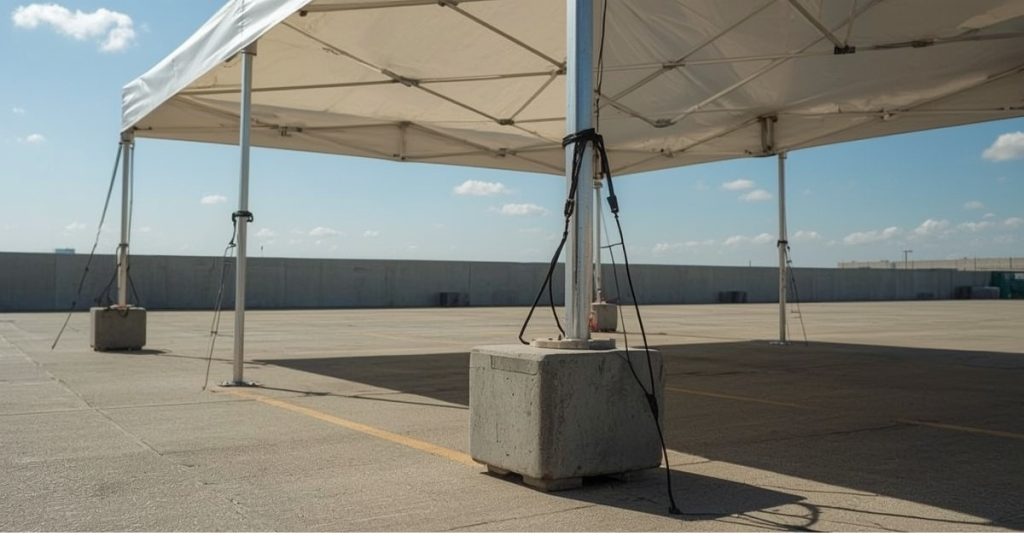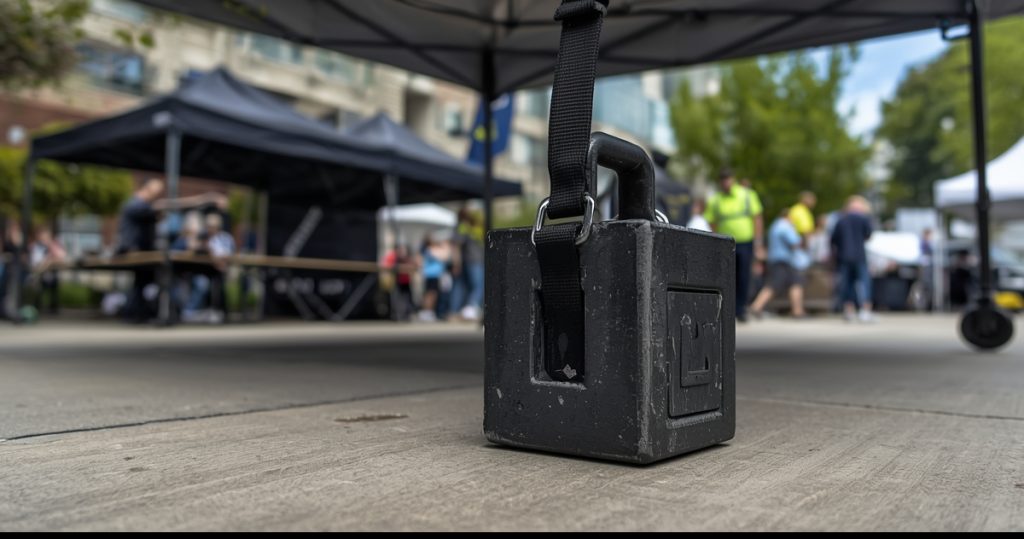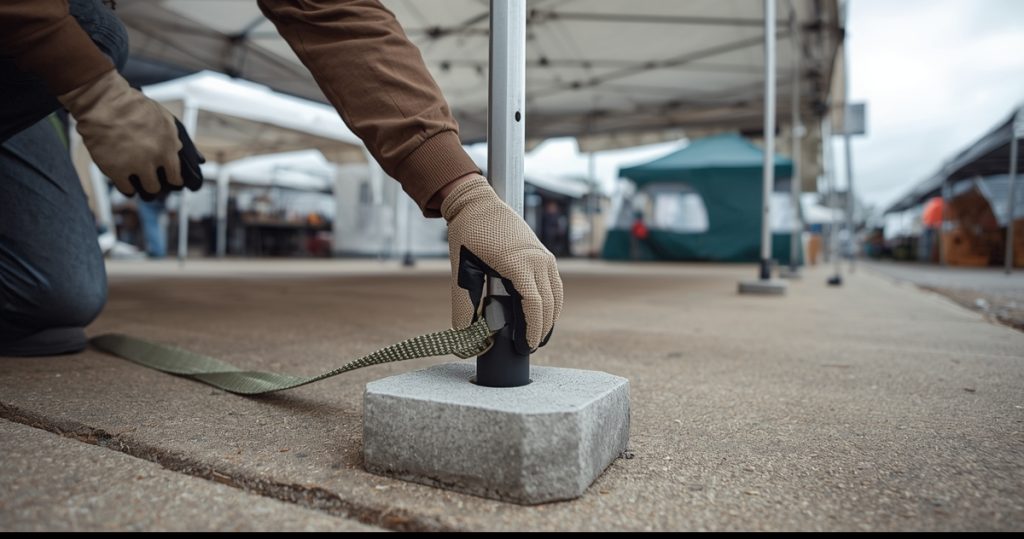As an Amazon Associate, I earn from qualifying purchases.
Setting up a canopy tent on concrete presents unique challenges, as hard surfaces prevent traditional staking methods. Unlike grass or dirt, concrete requires alternative anchoring solutions to keep your tent secure and stable. Whether you’re hosting an outdoor market, a tailgate party, or a community event, proper tent anchoring is essential—wind can easily turn an unsecured canopy into a dangerous projectile, risking injury and property damage.
The good news is that with the right canopy tent weights and effective securing techniques, you can create a stable setup that withstands various weather conditions. This guide walks you through proven methods for anchoring canopy tents on concrete, covering the best weight options, step-by-step procedures, and practical safety tips to ensure your tent stays exactly where you need it, providing both safety and peace of mind.
Contents
Why Securing a Canopy Tent on Concrete Is Important

Proper tent anchoring goes far beyond simple convenience—it’s a matter of safety and responsibility. An unsecured canopy tent can become airborne in winds as low as 15-20 mph, creating serious hazards for anyone nearby.
Prevents Accidents and Injuries
Wind can lift an unanchored tent without warning, potentially striking bystanders or causing people underneath to panic and get hurt. Even a moderate breeze can cause an unstable tent to collapse or shift suddenly, creating dangerous situations for vendors, customers, or event attendees.
Protects Your Investment
Canopy tents represent a significant financial investment, and replacement costs can quickly add up. Wind damage often results in bent frames, torn fabric, or broken joints that may not be covered under warranty. Proper anchoring extends your tent’s lifespan and prevents costly repairs.
Ensures Compliance with Regulations
Many venues, municipalities, and event organizers require proof of proper tent anchoring before issuing permits. Some insurance policies also mandate specific anchoring standards for outdoor events. Understanding how to secure a canopy tent without stakes ensures you meet these requirements and avoid potential liability issues.
Maintains Professional Appearance
A wobbly, unstable tent reflects poorly on your business or event. Customers and attendees notice when setups look precarious, which can impact your reputation and bottom line. Proper anchoring creates a professional, trustworthy appearance that inspires confidence.
Effective Methods to Hold Down a Canopy Tent on Concrete

When setting up a canopy tent on concrete surfaces, securing it properly is essential to ensure safety, stability, and durability. Unlike grassy or soft terrain, concrete requires specific anchoring techniques that provide reliable support without the use of traditional stakes. Whether you are hosting an outdoor event, managing a vendor booth, or creating a shaded area, utilizing the right methods to anchor your tent will prevent accidents, protect your equipment, and maintain a professional look. By understanding and applying these targeted approaches, you can confidently set up your canopy tent on hard surfaces, even in challenging weather conditions.
Weighted Tent Bags
Weighted tent bags offer one of the most popular solutions for concrete anchoring. These specially designed bags can be filled with sand, gravel, or water and attached directly to tent legs using straps or bungee cords. High-quality weighted bags typically feature double-stitched seams, weather-resistant materials, and secure closure systems.
The main advantage of weighted bags lies in their portability when empty and their customizable weight capacity. Most bags can hold 20-50 pounds of material, and you can adjust the weight based on expected weather conditions. Sand provides consistent weight and won’t freeze, while water offers convenience but may leak if the bag gets punctured.
Commercial Concrete Weights
Purpose-built concrete weights or ballast bags represent the most robust option for tent anchoring. These professionally manufactured weights typically range from 25-75 pounds each and feature built-in attachment points specifically designed for tent applications.
Commercial weights often include wheels for easy transportation and stackable designs for efficient storage. While more expensive than DIY solutions, they provide consistent performance and durability that justifies the investment for frequent tent users.
Water Barrels and Large Containers
Standard water barrels, large storage containers, or even five-gallon buckets can serve as effective anchoring points when properly secured to tent legs. A five-gallon bucket filled with concrete creates approximately 60-70 pounds of anchoring force, while water barrels can provide 100+ pounds when full.
This method works well for permanent or semi-permanent installations where moving the weights isn’t a primary concern. However, transportation and setup require more effort compared to purpose-built solutions.
Weighted Plates and Steel Weights
Steel plates, barbell weights, or specially designed tent weights offer excellent stability with relatively compact footprints. These dense materials provide maximum holding power per square inch, making them ideal for situations where space is limited.
Many steel weight systems feature quick-release mechanisms and ergonomic handles for easier handling. Some designs stack together for storage and separate for use, offering good balance between anchoring power and portability.
Tie-Down Systems to Fixed Structures
When available, nearby fixed structures like fence posts, light poles, or building anchors can provide excellent tie-down points. This method requires high-quality straps or cables rated for outdoor use and proper angles to distribute forces effectively.
Always obtain permission before attaching to someone else’s property, and use protective padding to prevent damage to both the structure and your equipment. This approach works best in combination with weighted anchors rather than as a standalone solution.
Step-by-Step Guide to Securing a Canopy Tent on Concrete
Setting up a canopy tent on concrete can be tricky since traditional stakes aren’t an option. To keep your tent stable and safe, you’ll need reliable anchoring methods that can withstand wind and movement. This guide walks you through proven solutions like weighted anchors, strap-and-anchor systems, and combination techniques designed specifically for hard surfaces. With the right approach, you can set up your canopy confidently on any concrete area—whether it’s a patio, parking lot, or event space—without worrying about it shifting or tipping over.
Step 1: Position and Assess Your Setup
Before installing any weights, fully assemble your canopy tent in its final position. Check that all frame connections are tight and the fabric is properly tensioned. Identify the four corner anchor points where weights will attach, and ensure you have clear access to each location.
Survey the area for potential hazards like overhead power lines, nearby vehicle traffic, or pedestrian pathways that might be affected if the tent shifts. Consider wind direction and any nearby structures that might create wind tunnels or downdrafts.
Step 2: Calculate Required Weight
Determine the total anchoring weight needed based on your tent size and expected conditions. As a general rule, plan for at least 30-40 pounds per corner for a standard 10×10 tent in moderate conditions. Increase this to 50+ pounds per corner for larger tents or when strong winds are expected.
Weather services typically provide wind speed forecasts, and you should plan anchoring accordingly. Winds of 20-25 mph require significantly more anchoring weight than 10-15 mph conditions.
Step 3: Attach Weights to Tent Legs
Secure your chosen weights to each tent leg using appropriate straps, bungee cords, or attachment systems. Position weights as close to the base of each leg as possible to maximize stability. If using weighted bags, ensure they sit flat against the ground rather than hanging in mid-air.
For maximum effectiveness, weights should pull downward rather than outward. This means attachment points should be positioned to create vertical tension on the tent frame rather than horizontal stress that could cause structural damage.
Step 4: Verify All Connections
Once all weights are attached, systematically check each connection point for proper tension and security. Straps should be tight enough to prevent slipping but not so tight that they damage the tent frame or fabric.
Test the stability by gently pushing against the tent frame at various points. The structure should feel solid and resist movement without excessive flexing or shifting.
Step 5: Add Supplementary Anchoring
For challenging conditions or extra security, consider additional tie-down points using guy-lines attached to secondary weights positioned away from the main tent structure. These create a wider stability base and help distribute wind forces more effectively.
Some tent users also add weights to the center support poles if their tent design includes them. This provides additional downward force and helps prevent the characteristic “umbrella effect” that can occur in strong winds.
Tips for Choosing the Right Weights and Accessories

The right weights and accessories can make all the difference in keeping your tent secure and easy to manage. Always choose durable, weather-resistant materials that can handle long exposure to sun, rain, and wind. Match your choice to the terrain—sandbags work best on beaches, water weights are great for flat campsites, and heavy-duty stakes excel on solid ground. Adding modular accessories like adjustable guy-lines or reinforced straps boosts stability and gives you flexibility in changing conditions. Whenever possible, opt for lightweight, portable options so your setup stays reliable without becoming a burden to carry
Material Considerations
Look for weights made from weather-resistant materials that won’t degrade from UV exposure, moisture, or temperature fluctuations. Vinyl and heavy-duty polyester fabrics work well for weighted bags, while powder-coated steel resists corrosion in metal weights.
Avoid materials that might stain concrete or surrounding surfaces. Some sand types can leave residue, and certain metals might create rust marks if they scratch against hard surfaces.
Portability vs. Stability Balance
Heavier anchoring systems provide better stability but create transportation and setup challenges. Consider your typical use patterns when selecting equipment. Frequent travelers might prioritize collapsible or fillable options, while permanent installations can use heavier, more robust solutions.
Wheels, handles, and carrying cases can significantly improve the usability of heavier anchoring systems. Factor these convenience features into your decision-making process.
Quick-Release and Adjustment Features
Look for anchoring systems with quick-release buckles, adjustable straps, or snap-on connections that speed up setup and breakdown. Time saved during installation allows for better overall preparation and reduces the temptation to skip proper anchoring when you’re in a hurry.
Some advanced systems include tension indicators that show when proper anchoring force is achieved, taking guesswork out of the installation process.
Storage and Maintenance Requirements
Consider where and how you’ll store anchoring equipment between uses. Weighted bags that can be emptied and folded flat require much less storage space than solid weights. However, refilling bags before each use adds time to your setup process.
Plan for equipment maintenance including cleaning, inspection for wear, and replacement of consumable components like straps or buckles. Quality anchoring equipment should provide years of reliable service with proper care.
Wrapping Up
Mastering the proper techniques for anchoring canopy tents on concrete is essential for ensuring both safety and reliability during outdoor events. By using tested methods and investing in quality weights or anchoring systems, you not only protect your equipment but also create a safer environment for everyone around. Remember, anchoring isn’t a one-time task—weather and conditions can shift quickly, so regular checks and adjustments are key. With consistent care and the right tools, your canopy will remain secure, professional-looking, and ready to serve you through countless successful events.
Frequently Asked Questions
Can I use water jugs as weights for canopy tents?
Yes. Water jugs can serve as temporary weights when securely attached to tent legs. A gallon of water weighs about 8 pounds, so multiple jugs per corner are needed for adequate anchoring. Use strong straps or bungee cords, and be aware that plastic containers may crack under stress or temperature changes.
How heavy should weights be for a 10×10 canopy tent?
For a standard 10×10 canopy tent, aim for 120–160 pounds total, distributed evenly across all four corners (about 30–40 pounds per corner) in moderate conditions. Increase to 200+ pounds total (50+ per corner) when expecting strong winds or in exposed locations.
Are there special weights made for tents on concrete?
Yes. Many manufacturers offer purpose-built tent weights for hard surfaces. These often include built-in attachment points, ergonomic handles, wheels for easy transport, and weather-resistant construction. Purpose-built weights generally provide better stability and convenience than improvised solutions.
Can I tie my tent to nearby poles or fences instead?
Tying to fixed structures can supplement but should not replace weighted anchoring. Always get permission before using someone else’s property and use padding to prevent damage. Be cautious, as tie-downs may create trip hazards or restrict emergency access.
Is it safe to use sandbags on concrete surfaces?
Yes, if properly designed for tent anchoring. Use reinforced, weather-resistant sandbags with secure closures. Avoid construction-grade sandbags, which may leak and are not built for repeated use. Position sandbags carefully to prevent trip hazards for pedestrians.
As an Amazon Associate, I earn from qualifying purchases.
